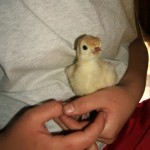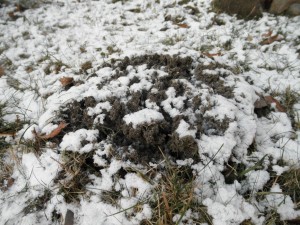
Stockpiling forage for winter feed was fairly limited this year in our area due to dry soil conditions when most stockpiling growth should have occurred. More stored forage will be required this year and feeding hay has started much sooner than in recent years for many producers.
Loss, associated with feeding hay to livestock, may be much more than just storage loss if precautions are not taken to reduce waste during the feeding operation. Feeding loss is a product of many things. Trampling, leaf shatter, quality deterioration, fecal contamination, and refusal are all things that contribute to waste. One must expect some hay loss during feeding, but the amount of loss may be reduced through good management practices and proper planning.
Feeding losses have been shown to range from less than 2 percent, where great care was taken, to more than 60 percent when no attempt was made to reduce hay loss. A loss of 3 percent to 6 percent would be considered normal, but good management practices must be in place to accomplish this.
Feeding hay throughout various paddocks from moveable racks or wagons promotes distribution of manure rather than concentrating it in one location. Many types of feed bunks, bale rings and other equipment are available today, but the ones which keep hay from contacting the ground generally reduce waste the most. A dry, well‑drained or frozen site should be chosen for feeding hay when possible. Limiting hay fed to a one‑day supply, with enough space for all animal to eat at the same time, helps reduce waste.
Some managers like to feed several bales in one area, which allows them to select a convenient feeding location and minimizes the area of sod killed. However, this eventually results in muddy conditions, often promoting weed pressure. It may also result in soil erosion or soil compaction. If these conditions are encountered, it is very likely that the area used will be unproductive for forage growth much of the following year and weed growth may be a problem. If this occurs, weeds should be controlled before they go to seed.
Unrolling large round bales is a practice which many of our producers have implemented where terrain and or equipment permit. If this method is used, only unroll enough feed for one day’s supply or use an electric wire over the middle of the unrolled swath to prevent trampling and bedding on the food source. Moving to a new area each feeding promotes even manure distribution and this type nutrient management will help produce more forage next year.

Many producers use the unrolling` method to promote re‑seeding in places with sparse vegetation. Unused forages help to increase organic material and fertility in these feeding areas. Feeding priority of various hay lots should also be considered when using the feed. Hay exposed to the elements/outdoor should be fed first to reduce loss.
Separating livestock into smaller groups with similar nutritional needs is recommended. The highest quality hay should be fed to young, growing livestock or lactating animals. Lower quality hay should be used for livestock with lower nutritional needs, such as bulls and non‑lactating cows. Sending samples to a laboratory for forage analysis is recommended so actual nutritional values are known.
If you have low quality hay, a good way to use it is to combine it with forage in stockpiled paddocks. Most stockpiled grasses, when fed in a timely manner, contain higher protein levels and more total digestible nutrients than many lots of hay which were harvested in the summer. If you are going to place round bales in stockpiled forage, use a front electric wire to limit livestock’s access, thereby controlling waste of the stockpiled forage and the round bales.
A heavy use feeding area, constructed of concrete, geotextile cloth and stone, or other suitable material, is a good place to feed livestock when conditions are very wet, muddy and not suitable for feeding in your fields. Using heavy use areas at proper times reduces pugging and injury to forage plants in the paddocks.
Whatever feeding method is used, your management decisions determine the impact to the land on your farm. Establishing good management practices can alleviate unsightly problems, reduce soil erosion, increase water quality, increase forage production and boost profit margins.








 (OSU Beef Team Newsletter)
(OSU Beef Team Newsletter)